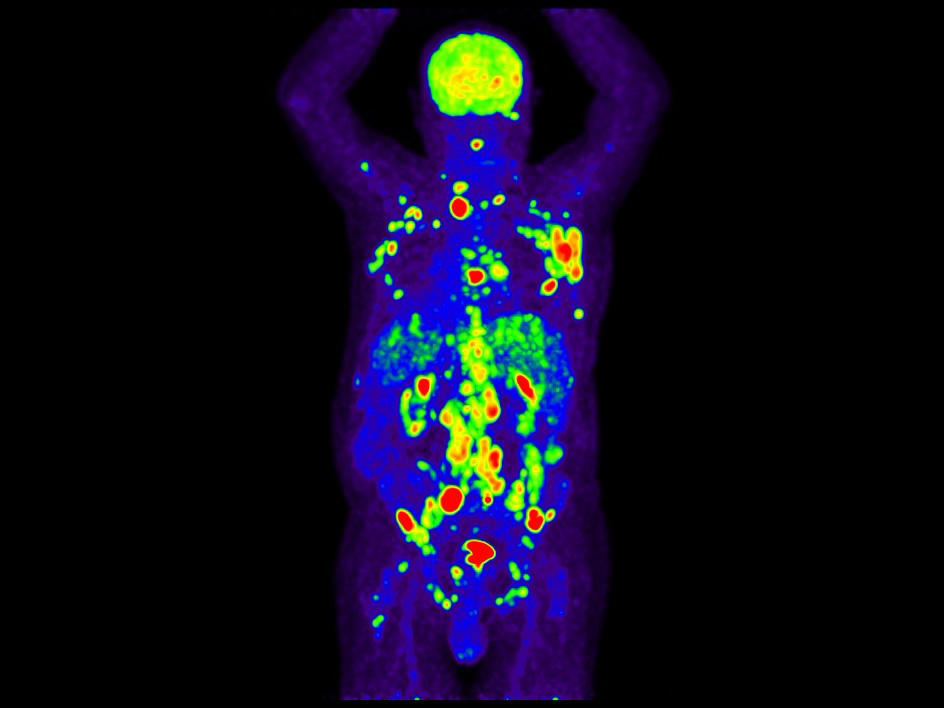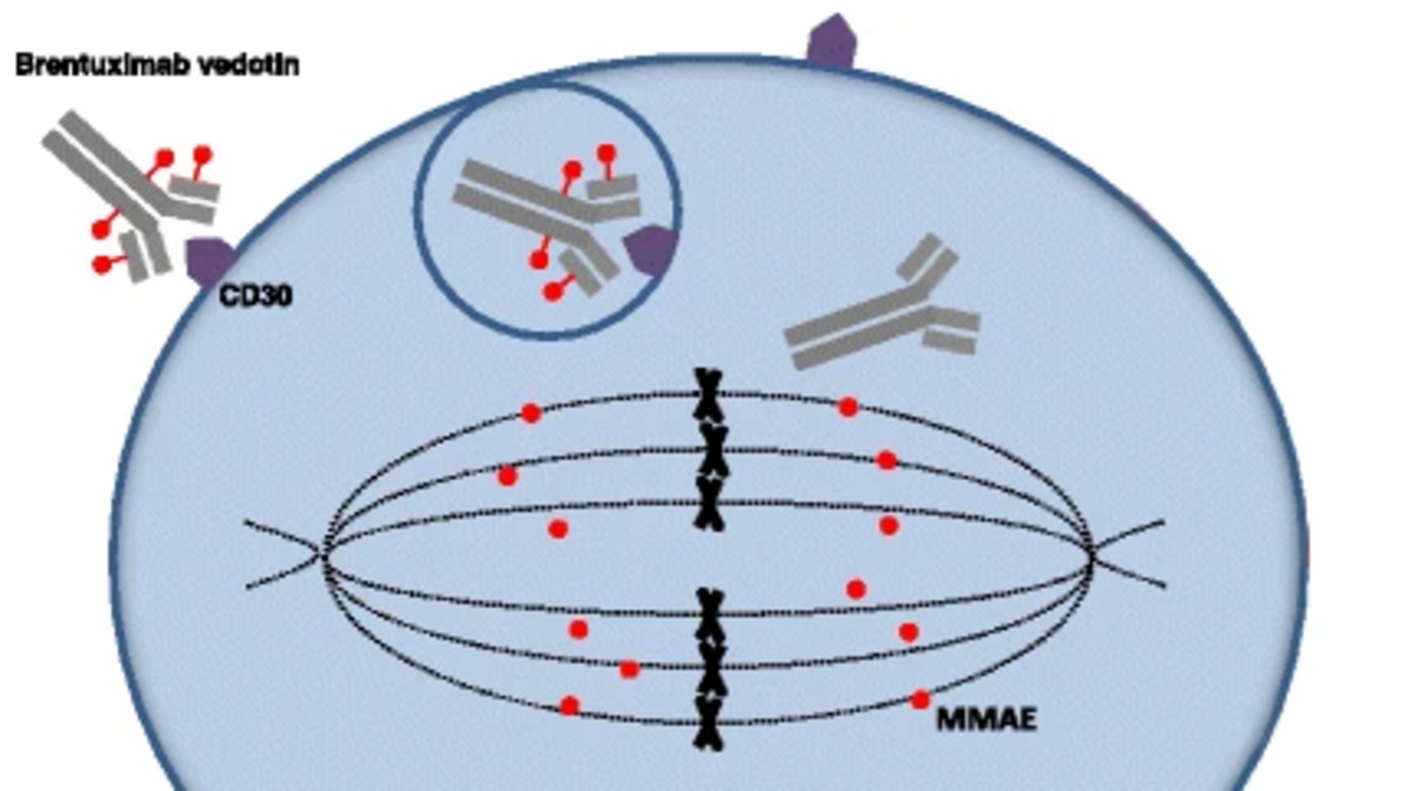Nivolumab Appears to Boost Cure Rate in Advanced Hodgkin Lymphoma
, by Carmen Phillips
The immunotherapy drug nivolumab (Opdivo) should be part of the initial treatment of teens and adults with advanced forms of classic Hodgkin lymphoma, according to updated results from a large NCI-funded clinical trial.
In the nearly 1,000-patient trial, treatment with nivolumab and a three-drug chemotherapy regimen called AVD was better at eliminating cancer and keeping it at bay than the current standard initial treatment for the disease, AVD combined with the targeted therapy brentuximab (Adcetris).
Two years after starting treatment, about 92% of trial participants randomly assigned to the nivolumab–AVD group were alive without their cancer starting to grow again—a measure known as progression-free survival—compared with 83% in the brentuximab–AVD group. People in the nivolumab–AVD group also had fewer side effects overall and fewer serious side effects, according to findings reported October 17 in the New England Journal of Medicine.
The trial’s lead investigator, Jonathan Friedberg, M.D., director of the Wilmot Cancer Institute at the University of Rochester, explained that, historically, most people with advanced Hodgkin lymphoma whose cancer has not returned within 2 years of completing their initial treatment are cured.
Based on these new findings, Dr. Friedberg said, “we’re curing substantially more patients” with the nivolumab–AVD regimen.
During a press briefing on the study’s results, Dr. Friedberg explained that only seven people in the study received radiation therapy after completing their drug treatment—even though one-quarter of trial participants were between the ages of 12 and 17.
Many people in this age group diagnosed with Hodgkin lymphoma get radiation therapy, often as a safeguard to help prevent the cancer from coming back. But the radiation can have severe downsides, including causing long-term health problems like second cancers, he said. To limit these long-term side effects, the trial was designed so that radiation therapy would only be used under very strict conditions in this age group.
Given the excellent outcomes seen in people treated with nivolumab and AVD, Dr. Friedberg said, oncologists can feel confident following this approach.
“We've largely eliminated radiation therapy as part of the [initial] treatment,” he said. “We now have a more effective, less toxic regimen that should not only have fewer short-term side effects, but also fewer long-term side effects.”
A shift from brentuximab to nivolumab
Most people diagnosed with classic Hodgkin lymphoma will be cured, even those who are diagnosed when the cancer is advanced.
Brentuximab–AVD has been a standard initial, or first-line, treatment for advanced Hodgkin lymphoma for about a decade. Although it’s been shown to modestly improve progression-free survival, brentuximab can have substantial side effects, including intense pain and tingling in the hands and feet (known as peripheral neuropathy), along with diarrhea and other stomach problems. In fact, many people stop taking the regimen because of side effects.
Nivolumab is already used as a stand-alone treatment for advanced Hodgkin lymphoma that has returned after first-line treatment. The results with nivolumab as a second-line treatment have been so good, Dr. Friedberg said, that the next logical step was to test nivolumab as part of the initial treatment.
Better progression-free survival, fewer side effects, almost no radiation
Conducted by the SWOG Cancer Research Network, an NCI-funded clinical trials group, the study enrolled nearly 1,000 participants from hospitals across the United States. Overall, 12% of the participants were Black and 13% were Hispanic, Dr. Friedberg noted, with this diversity meaning its results are applicable to the general population of people with this disease.
Hodgkin lymphoma is one of the most common cancers diagnosed in adolescents, but adolescents and adults have not generally been included in the same clinical trials and given the same treatments. For this trial, SWOG researchers collaborated with researchers from the NCI-funded Children’s Oncology Group to design the study to enroll adolescents as well as adults, Dr. Friedberg said. Overall, about 240 participants were ages 12 to 17.
Part of that collaboration involved developing criteria for when radiation therapy was allowed to be used. Under these criteria, radiation could only be used in patients who, after completing drug treatment, had evidence of remaining cancer on imaging scans that met very specific conditions. Otherwise, radiation could not be used.
Despite the robust improvement in 2-year progression-free survival in the nivolumab–AVD group, there’s almost no difference between the two treatment groups in the percentage of people alive overall at 2 years: 99% versus 98%. But that’s to be expected, given that these data are based on such short follow-up, Dr. Friedberg said. Even people whose cancer comes back can be cured with second-line treatments or live for many years.
Nearly all side effects were worse in the brentuximab–AVD group, in particular peripheral neuropathy. Side effects considered to be serious were also more common in this group, and more patients stopped treatment altogether because of side effects.
Seven deaths occurred in the nivolumab–AVD group, three of which were judged to have been related to the treatment. By contrast, there were 14 deaths in the brentuximab–AVD group, eight of which were treatment related.
According to Paul Harker-Murray, M.D., of Children’s Wisconsin and who specializes in treating lymphomas, the findings are convincing.
The nivolumab–AVD regimen and approach to radiation treatment used in the trial “will very likely be considered the new standard of care for the adolescent and young adult population at many [cancer] centers,” said Dr. Harker-Murray, who wasn’t involved in the study.
Many Hodgkin lymphoma researchers had assumed that the ability to cure advanced Hodgkin lymphoma with current therapies “had probably been maximized,” wrote James Armitage, M.D., of the University of Nebraska Medical Center, and Dan Longo, M.D., of Harvard Medical School, in an editorial that accompanied the trial’s results. The SWOG trial “undermines that assumption,” Drs. Armitage and Longo wrote.
Although trial participants need to be followed for longer to determine how the treatment holds up over time, there’s plenty of reason for optimism about the nivolumab–AVD regimen, they continued.
“Unless remissions induced by immune checkpoint blockade plus chemotherapy are different from those induced by chemotherapy alone, late relapses would be unexpected,” they wrote.
A new standard of care for advanced Hodgkin lymphoma
A spokesperson for Bristol Myers Squibb, which makes nivolumab, said that the company doesn’t comment on their plans for requesting approvals from the Food and Drug Administration. So, it’s unclear when the drug could potentially be approved for this specific use.
Even in the absence of FDA approval, Dr. Friedberg said he expects that expert guidelines for treating Hodgkin lymphoma in adults and children will be revised to recommend nivolumab–AVD as the preferred initial treatment for people with advanced disease.
Drs. Armitage and Longo explained that the results are particularly important for patients aged 60 and older, who often have “a much poorer treatment outcome” than younger patients. The 2-year progression-free survival rate of 88% among those in this age group treated with nivolumab–AVD “is probably the best ever reported,” they wrote.
In addition, the brentuximab–AVD regimen had “a particularly unacceptable side-effect profile among older patients, with one-third discontinuing all treatment early,” Dr. Friedberg and his colleagues wrote. “On the basis of these findings, the use of [brentuximab]–AVD should probably be avoided in older patients.”
Trial investigators are now analyzing levels of tumor DNA in blood samples collected from trial participants. The results of those studies can guide future research about whether levels of circulating tumor DNA can help clinicians fine-tune treatment decisions even further, Dr. Friedberg said.
According to Dr. Harker-Murray, there are several ongoing studies testing ways to make treatments safer for adolescents with Hodgkin lymphoma. There’s also potential, he continued, to use nivolumab and brentuximab as an initial treatment. The two are already used together in some people whose cancer has returned after multiple earlier treatments.
“The combination is extremely active in [these] patients … and the side effects are limited,” he said.

